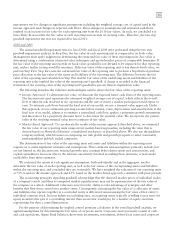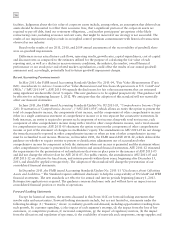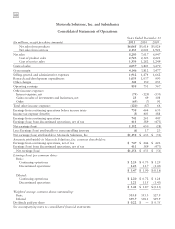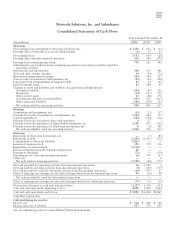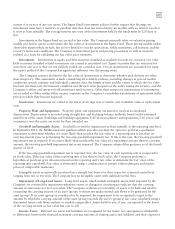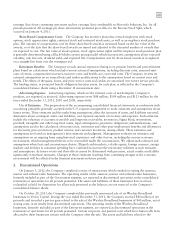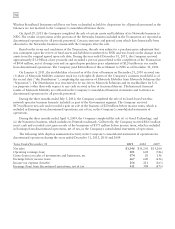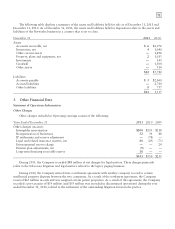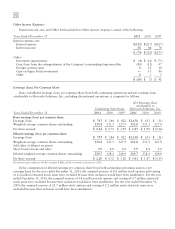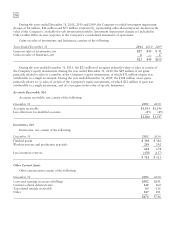Motorola 2011 Annual Report Download - page 71
Download and view the complete annual report
Please find page 71 of the 2011 Motorola annual report below. You can navigate through the pages in the report by either clicking on the pages listed below, or by using the keyword search tool below to find specific information within the annual report.
65
accounting guidance. The Company recognizes revenue in accordance with software accounting guidance for the
following types of sales transactions: (i) standalone sales of software products, (ii) sales of software upgrades and
(iii) sales of software bundled with hardware not essential to the functionality of that hardware.
Products—For product sales, revenue recognition occurs when products have been shipped, risk of loss has
transferred to the customer, objective evidence exists that customer acceptance provisions have been met, no
significant obligations remain and allowances for discounts, price protection, returns and customer incentives can be
reliably estimated. Recorded revenues are reduced by these allowances. The Company bases its estimates of these
allowances on historical experience taking into consideration the type of products sold, the type of customer, and
the specific type of transaction in each arrangement. Where customer incentives cannot be reliably estimated, the
Company recognizes revenue at the time the product sells through the distribution channel to the end customer.
The Company sells software and equipment obtained from other companies. The Company establishes its own
pricing and retains related inventory risk, is the primary obligor in sales transactions with customers, and assumes
the credit risk for amounts billed to customers. Accordingly, the Company generally recognizes revenue for the sale
of products obtained from other companies based on the gross amount billed.
Within the Enterprise segment, products are primarily sold through distributors and value-added resellers
(collectively “channel partners”). Channel partners may provide a service or add componentry in order to resell our
products to end users. Sales to channel partners where the Company cannot reliably estimate the final sales price or
when a channel partner is unable to pay for our products without reselling them to their customers, revenue is not
recognized until the products are resold by the channel partner to the end customer.
Long-Term Contracts—For long-term contracts that involve customization of equipment and/or software, the
Company generally recognizes revenue using the percentage of completion method based on the percentage of costs
incurred to date compared to the total estimated costs to complete the contract. In certain instances, when revenues
or costs associated with long-term contracts cannot be reliably estimated or the contract contains other inherent
uncertainties, revenues and costs are deferred until the project is complete and customer acceptance is obtained.
When current estimates of total contract revenue and contract costs indicate a contract loss, the loss is recognized in
the period it becomes evident.
Services—Revenue for services is generally recognized ratably over the contract term as services are performed.
Software and Licenses—Revenue from pre-paid perpetual licenses is recognized at the inception of the
arrangement, presuming all other relevant revenue recognition criteria are met. Revenue from non-perpetual licenses
or term licenses is recognized ratably over the period that the licensee uses the license. Revenue from software
maintenance, technical support and unspecified upgrades is recognized over the period that these services are
delivered.
Multiple-Element Arrangements—Arrangements with customers may include multiple deliverables, including
any combination of product, services and software. These multiple element arrangements could also include an
element accounted for as a long-term contract coupled with other product, services and software. For multiple-
element arrangements that include product containing software essential to the equipment’s functionality,
undelivered software elements that relate to the product’s essential software, and undelivered non-software services,
deliverables are separated into more than one unit of accounting when (i) the delivered element(s) have value to the
customer on a stand-alone basis, and (ii) delivery of the undelivered element(s) is probable and substantially in the
control of the Company. In these arrangements, the Company allocates revenue to all deliverables based on their
relative selling prices. The Company uses a hierarchy to determine the selling price to be used for allocating revenue
to deliverables: (i) vendor-specific objective evidence of fair value (“VSOE”), (ii) third-party evidence of selling price
(“TPE”), and (iii) best estimate of selling price (“ESP”).
• VSOE—In many instances, products are sold separately in stand-alone arrangements as customers may
support the products themselves or purchase support on a time and materials basis. Additionally, advanced
services such as general consulting, network management or advisory projects are often sold in stand-alone
engagements. Technical support services are also often sold separately through renewals of annual contracts.
The Company determines VSOE based on its normal pricing and discounting practices for the specific
product or service when sold separately. In determining VSOE, the Company requires that a substantial
majority of the selling prices for a product or service fall within a reasonably narrow pricing range, generally


